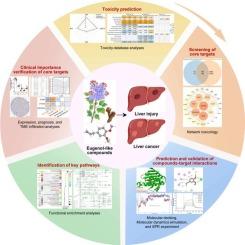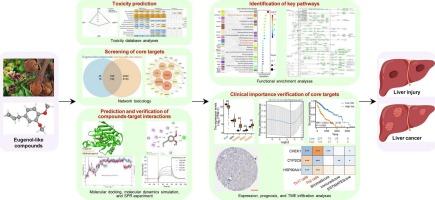Unveiling the toxicity secrets of eugenol-like compounds: from interaction mechanisms to treatment strategies
IF 9.7
1区 环境科学与生态学
Q1 ENVIRONMENTAL SCIENCES
引用次数: 0
Abstract
Eugenol, isoeugenol, and methyleugenol are among the most widely used natural phenolic compounds in food, pharmaceuticals, and cosmetics. This study aims to comprehensively evaluate the toxicity and underlying mechanisms of eugenol-like compounds through integrating network toxicology, computational modeling, in vitro experiments, and disease bioinformatics. First, we established their association with liver diseases using toxicity prediction databases and published literature. Next, we anchored their core targets for inducing liver injury and liver cancer, particularly the top five targets—EGFR, SRC, HSP90AA1, TNF, and ESR1—through various compound, disease, and protein–protein interaction databases, alongside Cytoscape software. Molecular docking and dynamics simulation, combined with surface plasmon resonance experiments, confirmed stable binding of these compounds to core proteins. Functional enrichment analyses revealed significant enrichment of these targets in cancer-related pathways, signal transduction, viral infectious diseases, endocrine and metabolic diseases, and immune systems. Notably, chemical carcinogenesis–receptor activation and the IL-17 signaling pathway emerged as key cancer and immune-related pathways influencing liver diseases. Using multi-omics databases and R software, we validated the prognostic significance of these core targets in liver cancer patients. Based on three independent prognostic markers (CHEK1, CYP2C9, and HSP90AA1), we developed a novel risk-scoring system with robust predictive efficacy and demonstrated their correlation with tumor microenvironment infiltration, particularly Th2 and Th17 cell infiltration. These novel mechanistic insights and improved approaches enable more accurate safety assessments for eugenol-like compounds-based consumer products while informing innovative therapeutic strategies that combine multi-target and multi-pathway intervention with immunomodulation for liver disease management.


揭示丁香酚类化合物的毒性秘密:从相互作用机制到治疗策略
丁香酚、异丁香酚和甲基丁香酚是在食品、药品和化妆品中应用最广泛的天然酚类化合物。本研究旨在通过网络毒理学、计算模型、体外实验和疾病生物信息学等手段综合评价丁香酚类化合物的毒性和潜在机制。首先,我们利用毒性预测数据库和已发表的文献建立了它们与肝脏疾病的关联。接下来,我们通过各种化合物、疾病和蛋白质相互作用数据库以及Cytoscape软件,锚定了它们诱导肝损伤和肝癌的核心靶点,特别是前五大靶点——egfr、SRC、HSP90AA1、TNF和esr1。分子对接和动力学模拟,结合表面等离子体共振实验,证实了这些化合物与核心蛋白的稳定结合。功能富集分析显示,这些靶点在癌症相关途径、信号转导、病毒感染性疾病、内分泌和代谢疾病以及免疫系统中显著富集。值得注意的是,化学致癌-受体激活和IL-17信号通路成为影响肝脏疾病的关键癌症和免疫相关途径。利用多组学数据库和R软件,我们验证了这些核心靶点在肝癌患者中的预后意义。基于三个独立的预后标志物(CHEK1, CYP2C9和HSP90AA1),我们开发了一种具有强大预测功效的新型风险评分系统,并证明了它们与肿瘤微环境浸润,特别是Th2和Th17细胞浸润的相关性。这些新颖的机制见解和改进的方法使基于丁香酚类化合物的消费产品能够更准确地进行安全性评估,同时为肝病管理的多靶点和多途径干预与免疫调节相结合的创新治疗策略提供信息。
本文章由计算机程序翻译,如有差异,请以英文原文为准。
求助全文
约1分钟内获得全文
求助全文
来源期刊

Environment International
环境科学-环境科学
CiteScore
21.90
自引率
3.40%
发文量
734
审稿时长
2.8 months
期刊介绍:
Environmental Health publishes manuscripts focusing on critical aspects of environmental and occupational medicine, including studies in toxicology and epidemiology, to illuminate the human health implications of exposure to environmental hazards. The journal adopts an open-access model and practices open peer review.
It caters to scientists and practitioners across all environmental science domains, directly or indirectly impacting human health and well-being. With a commitment to enhancing the prevention of environmentally-related health risks, Environmental Health serves as a public health journal for the community and scientists engaged in matters of public health significance concerning the environment.
 求助内容:
求助内容: 应助结果提醒方式:
应助结果提醒方式:


